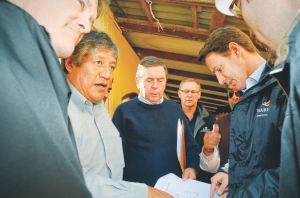SANTIAGO, CHILE — As dawn broke on Feb. 27, 2010, Chileans were aghast at the destruction wrought by a huge earthquake that had shook most of them from their sleep the night before.
From Santiago down the Central Valley, the country’s agricultural heartland to the industrial zone of Concepcion and Talcahuano, the quake ripped apart dozens of towns and villages.
The tsunami that followed washed away whole villages and left fishing boats and cargo containers stranded several blocks inland.
The death toll, of almost 500, was tragic but mercifully low given the enormity of the earthquake: at 8.8 on the Richter scale it was the fifth strongest since records began.
But the damage to homes, roads, schools, factories and other installations was enormous.
President Sebastian Piñera, who took office less than a fortnight after the disaster, put the cost at US$30 billion between emergency aid, lost production and damage to infrastructure.
Of that, around a third corresponded to the government — after weeks of hurried discussions and calculations, the president unveiled the government’s plan to foot the bill through a mix of budget savings, debt, withdrawals from sovereign wealth funds and tax rises.
Chile’s copper mining industry survived the earthquake largely unscathed: the bulk of the industry is located in the far north, far from the destruction.
Power supplies were cut to mines connected to central Chile’s SIC grid, such as the state-owned Andina and El Teniente divisions, Anglo American’s (AAL-L, AAUKY-Q) Los Bronces and El Soldado operations and Antofagasta (ANTO-L, ANFGY-O) subsidiary Antofagasta Minerals’ Los Pelambres copper mine.
But all were up and running within a few days.
That good fortune was partly due to location and also preparation: Jose Pablo Arellano, recently departed CEO of state-owned copper firm Codelco, said that the company had invested around US$50 million at El Teniente alone strengthening infrastructure in case of such an event.
Mining companies were fast to react to the earthquake through voluntary contributions.
Xstrata (XTA-L, XSRAY-Q) sent a team from its Lomas Bayas copper mine and a helicopter from its Energia Austral hydroelectric project to help with the rescue efforts.
Antofagasta plans to spend US$10 million rebuilding a dozen harbours and replacing fishing boats washed away by the tsunami to help get the local economy back on its feet.
Anglo American is spending a similar amount rebuilding schools and other building destroyed in the earthquake.
Despite these good deeds, the industry’s rapid recovery and expectations of bumper profits this year, thanks to high copper prices, has made it an obvious target for those looking for how the government will pay the huge bill left by the disaster.
Piñera, who had rejected calls to lift the mining royalty on the campaign trail, has had to think again.
The government’s financial package includes a temporary three-point rise in Chile’s corporation tax but Chile’s largely foreign-owned mining industry would be largely immune to this owing to tax invariability agreements made five years ago when the current mine royalty was introduced.
Instead, the government is proposing to replace the current duty on operating margin at a fixed rate of 4-5% with a variable rate that will range from 3.5-9% depending on the company’s profitability year to year.
But the invariability deals mean that almost all companies will not become liable to the new royalty scheme until these expire in 2017 or later so the government is offering an eight-year extension to invariability status for all companies that agree to pay under the variable rate during 2010 and 2011.
If copper prices continue at current levels above US$3.00 per lb., as most analysts expect, that should raise an additional US$700 million, the government says.
Mining Minister Laurence Golborne argues the modification is an improvement on the current system given the cyclical nature of the mining industry.
When copper prices are high and companies are enjoying huge profits, the government will skim off more; when prices inevitably fall and margins crushed, the tax burden will be lightened.
While understanding the need for tax increases, the leaders of Chile’s mining industry are less enamoured of the idea, arguing that it represents a change in the ground rules when they had been promised invariability and will mean that mining shoulders more of the burden than other sectors of the economy.
“We understand that we are in an emergency situation that justifies some transitory tax measures,” said Francisco Costabal, president of Chile’s Mining Council, which represents the industry’s biggest mines.
“But an increase in the specific tax that affects just one sector would be discriminatory towards mining and could affects its competitiveness in the world,” he added, soon after Piñera announced the measure.
Despite these concerns, Golborne is confident that the majority of companies will sign up to the government’s offer.
Paying more tax now, when Chile really needs it, could turn out a lot cheaper than exposing themselves to further tax rises later this decade.
But it is not just a question of economics, he noted.
With the Southern Hemisphere winter fast approaching, and copper prices close to pre-crisis highs, Chile’s mining companies are going to find themselves posting record profits while thousands of Chileans are still camped out under rain-sodden tarpaulin.
Refusing the deal would sully the industry’s careful efforts to appear socially responsible.
Digging a little deeper into their pockets would also be the right thing to do.
—Based in Santiago, the author is a freelance journalist specializing in mining. He can be reached at tomazzopardi@vtr.net.


Be the first to comment on "Post-quake Chile seeks more from copper miners"